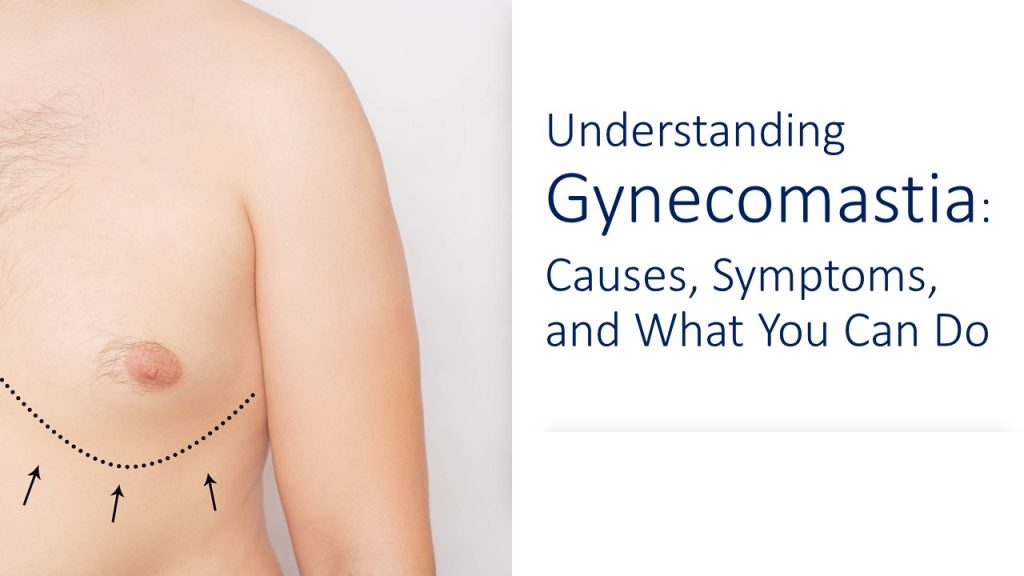Gynecomastia, often referred to as “man boobs,” is a common condition that affects men of all ages. It is characterized by the enlargement of breast tissue in males. While it’s not typically a serious medical concern, gynecomastia can cause discomfort and self-consciousness.
In Singapore, various medical aesthetic clinics offer treatments for gynecomastia. These treatments often involve procedures similar to those used in plastic surgery and cosmetic surgery, aiming to reduce the excess breast tissue and restore a more masculine chest contour. Some clinics even specialize in techniques inspired by Korean plastic surgery, known for their precision and minimal scarring.
In this article, we will delve into the causes, symptoms, and possible solutions for gynecomastia, including male breast reduction surgery.
Classification of Gynecomastia
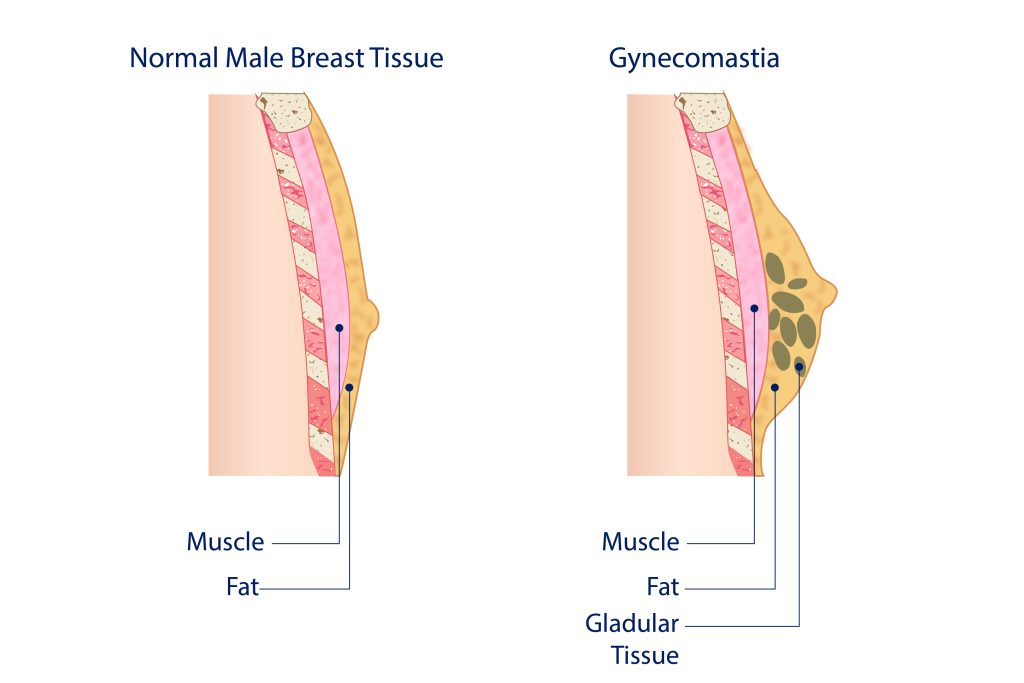
Gynecomastia is classified based on various factors, including its cause, duration, and severity. The primary classification categories are:
1. Physiological Gynecomastia: This category includes the natural occurrences of gynecomastia, often seen during life stages like puberty, old age, and infancy due to hormonal changes. It is generally temporary and resolves on its own.
2. Pathological Gynecomastia: This form is caused by underlying medical conditions or external factors. It can be further subdivided into:
- Drug-Induced Gynecomastia: Caused by medications or substances that interfere with hormonal balance, such as anti-androgens, steroids, and certain psychoactive drugs.
- Disease-Related Gynecomastia: Linked to health issues like liver or kidney disease, tumors, or hormonal disorders that affect the body’s estrogen and testosterone levels.
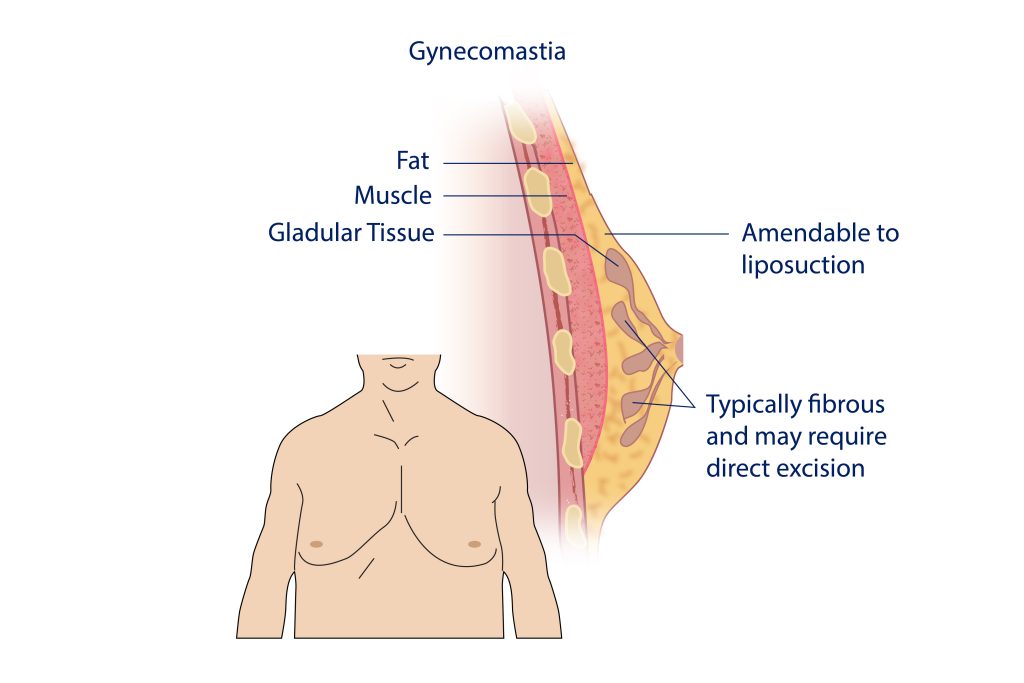
3. Pseudogynecomastia: This is not true gynecomastia but rather the appearance of enlarged breasts due to fat deposition, often associated with obesity. It lacks the glandular tissue proliferation seen in true gynecomastia.
4. Unilateral vs Bilateral: Gynecomastia can affect one breast (unilateral) or both breasts (bilateral). This classification is important for diagnostic and treatment approaches.
5. Severity-Based Classification: The severity-based classification of gynecomastia is crucial for determining the appropriate treatment approach. This classification typically ranges from a normal, non-pathological condition to four distinct grades:
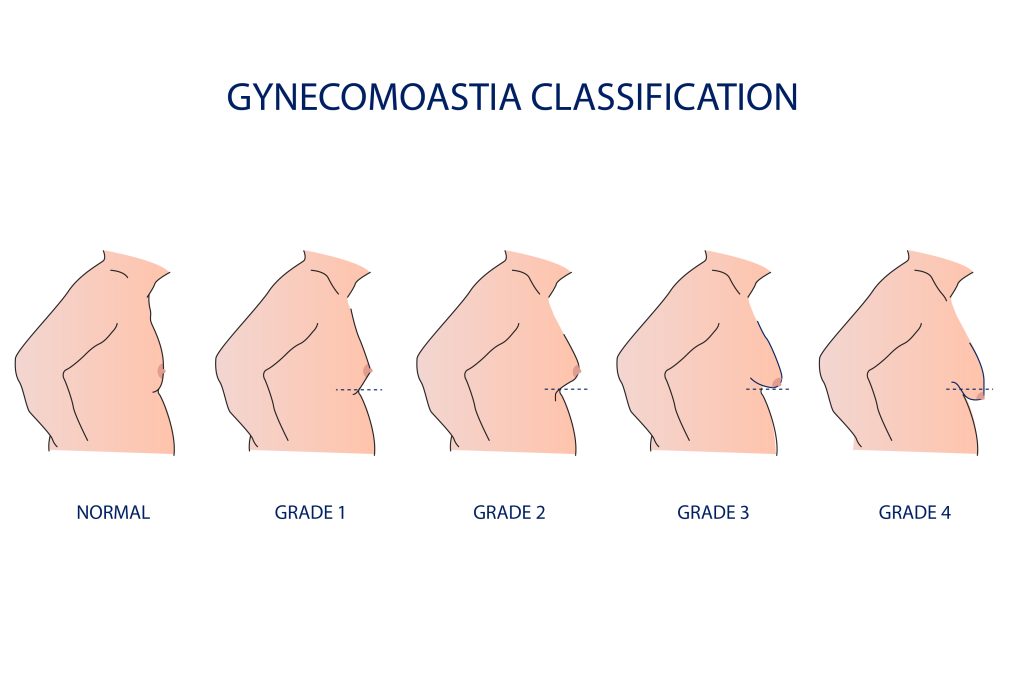
- Normal: In this stage, there is no significant enlargement of the breast tissue. It represents the baseline or absence of gynecomastia.
- Grade 1: This is a minor enlargement without skin excess. The breast enlargement is localized primarily around the nipple. In this stage, the condition is more of a cosmetic concern than a physical one.
- Grade 2: There is moderate breast enlargement exceeding areola boundaries with edges that are indistinct from the chest. At this stage, the breast tissue may start to become more noticeable under clothing.
- Grade 3: This grade involves moderate breast enlargement with skin excess. The breast tissue enlargement is more pronounced, and there is visible skin redundancy.
- Grade 4: This is marked by significant breast enlargement with marked skin excess, mimicking female breast contours. In this stage, the condition can cause not only cosmetic concerns but also physical discomfort, such as pain or tenderness.
Symptoms of Gynecomastia
Identifying the symptoms of gynecomastia is crucial in addressing the condition. The primary symptoms include:
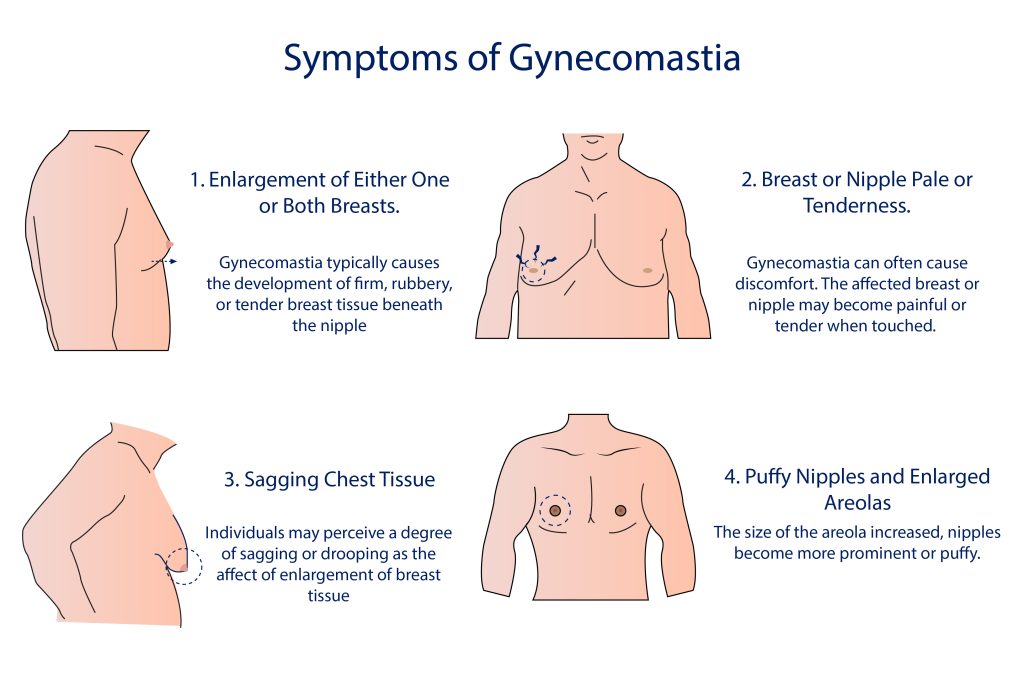
1. Enlargement of Either One or Both Breasts:
The most noticeable symptom of gynecomastia is the enlargement of breast tissue. This enlargement can vary in size, from a small, discreet lump to more significant breast development. It is important to distinguish gynecomastia from excess fat in the chest area. Gynecomastia involves the proliferation of actual breast tissue, whereas excess fat is typically addressed through diet and exercise.
2. Breast or Nipple Pain or Tenderness:
Gynecomastia can often cause discomfort. The affected breast or nipple may become painful or tender when touched. This discomfort can lead to increased self-consciousness and a desire to hide the condition, further impacting a person’s quality of life.
It’s worth noting that gynecomastia can affect men of all ages, from teenagers going through puberty to older individuals experiencing hormonal changes. Regardless of the underlying cause, recognizing the symptoms and seeking medical advice is the first step toward addressing the condition effectively.
Solutions for Gynecomastia
Treating gynecomastia varies depending on the cause and the severity of the condition. Sometimes, gynecomastia can resolve spontaneously, especially when it’s linked to hormonal shifts during puberty. Nonetheless, for individuals with persistent gynecomastia, there exist various treatment choices.
1. Lifestyle Changes:
For individuals with gynecomastia related to obesity, making lifestyle changes can be an effective first step. Engaging in regular exercise and maintaining a healthy diet to reduce excess body fat can lead to a noticeable improvement. It’s essential to remember that gynecomastia involves the growth of breast tissue, which may not be entirely reversible through lifestyle changes alone. However, a healthy lifestyle can help minimize the appearance of the condition.
2. Medication:
In some cases, medications may be prescribed to manage gynecomastia, particularly when it is associated with hormonal imbalances. These medications can help regulate hormone levels and potentially reduce breast tissue enlargement. However, the effectiveness of medications varies from person to person, and side effects should be discussed with a healthcare provider.
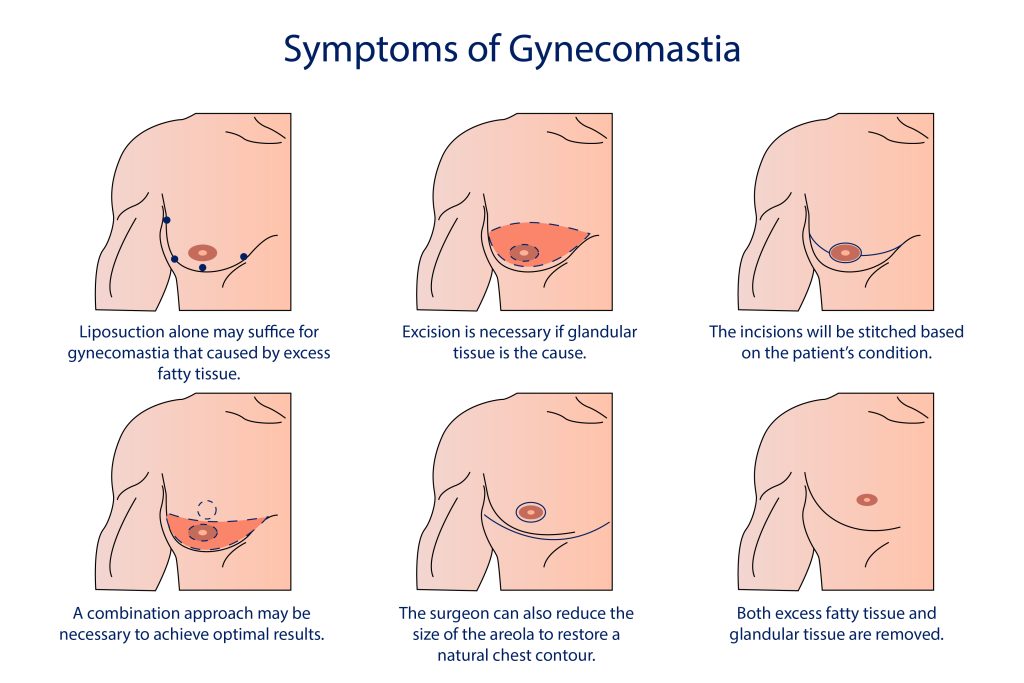
When gynecomastia is severe, persistent, or causing significant emotional distress, male breast reduction surgery is a highly effective solution. This surgical procedure, also known as gynecomastia surgery, involves the removal of excess breast tissue and reshaping the chest for a more masculine appearance. The surgery is performed by a plastic surgeon with expertise in male breast reduction procedures.
Guide On Choosing Your Doctor
Making the appropriate choice is pivotal when addressing an issue like gynecomastia. As much as we want it to be resolved as quickly as possible, it is advisable not to be too hasty in searching for help. Plenty of horror stories and botched jobs remind us of this importance.
Here are a few tips to note when deciding on your doctor.
Experience
An experienced doctor can not only identify the underlying issues of a condition, but they can also effectively address it safely with satisfying results. Look for a plastic surgeon who is experienced (with proven results) and one who is meticulous and particular about standards and quality.
Before & After Patient Photos
The doctor should be able to show you various grades of gynecomastia cases that they have performed in the form of “before” and “after” photos. Most often, these are good indicators of the quality, standard, and results you can expect.
Communication Skills
- It is essential that a doctor makes you feel comfortable and can answer your concerns and queries.
- The doctor should also be able to explain the reason/s why a particular procedure is chosen or preferred over another to address your issue.
- A doctor should be patient when addressing questions and concerns. He should not overwhelm or pressure a patient into agreeing to treatments that they (the patients) do not understand regarding the purpose of such treatments.
- A doctor should be able to convey his opinions in a manner that is easily understood and assure his patients, particularly in regard to their safety during the procedure.
Additionally, the clinic staff should also be exemplary in terms of the clinic’s quality and care standards. They ideally should have decent experience and knowledge in dealing with patients with different issues and needs.
Your experience from the moment you step into the clinic until you leave should cast a positive imprint and make you feel confident.
Bottomline
Gynecomastia is a common condition that can affect men of all ages, leading to the enlargement of breast tissue. While it may not pose a significant medical risk, gynecomastia can cause discomfort and self-consciousness. Understanding the common causes, symptoms, and available solutions is essential in managing this condition effectively.
Whether one chooses to explore lifestyle changes, medication, or surgical intervention, seeking guidance from a healthcare professional is crucial in determining the most suitable course of action. Gynecomastia, while challenging, can be effectively managed, allowing individuals to regain confidence and improve their quality of life.

